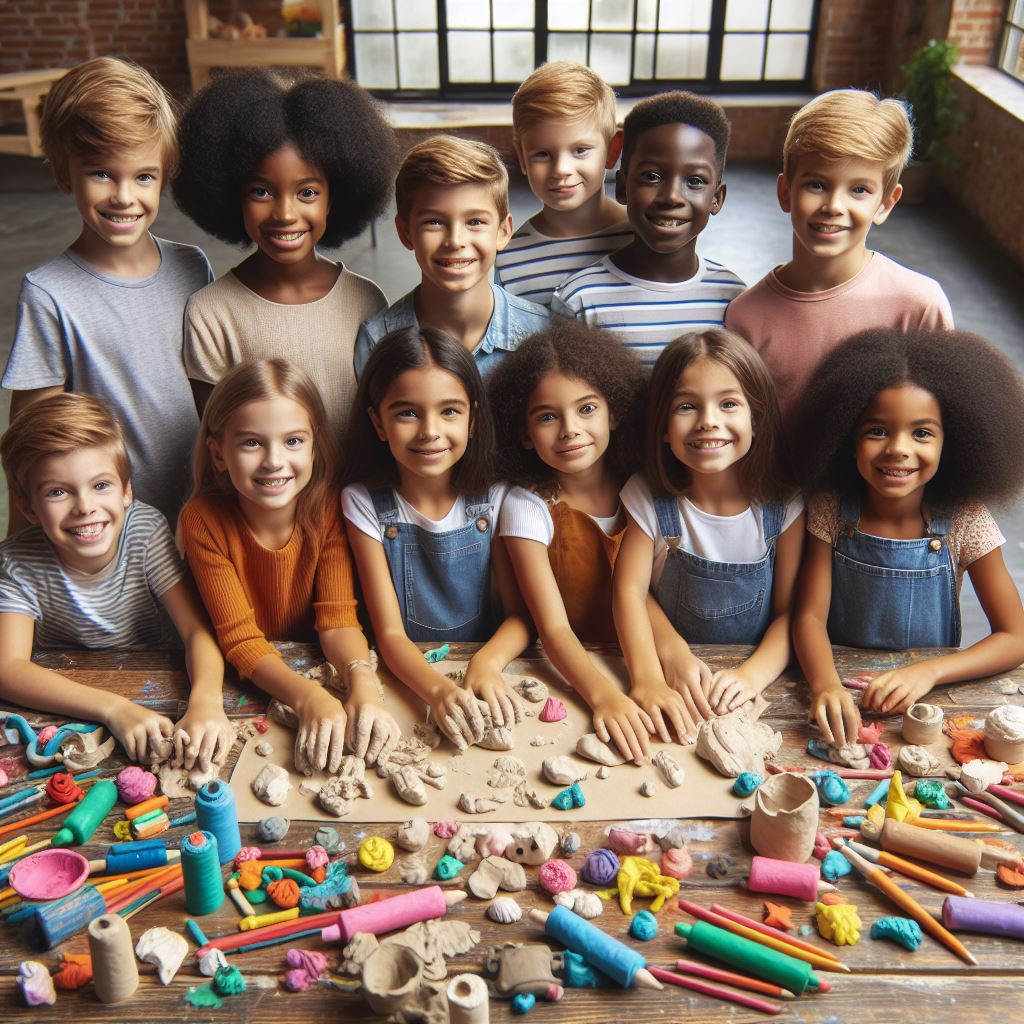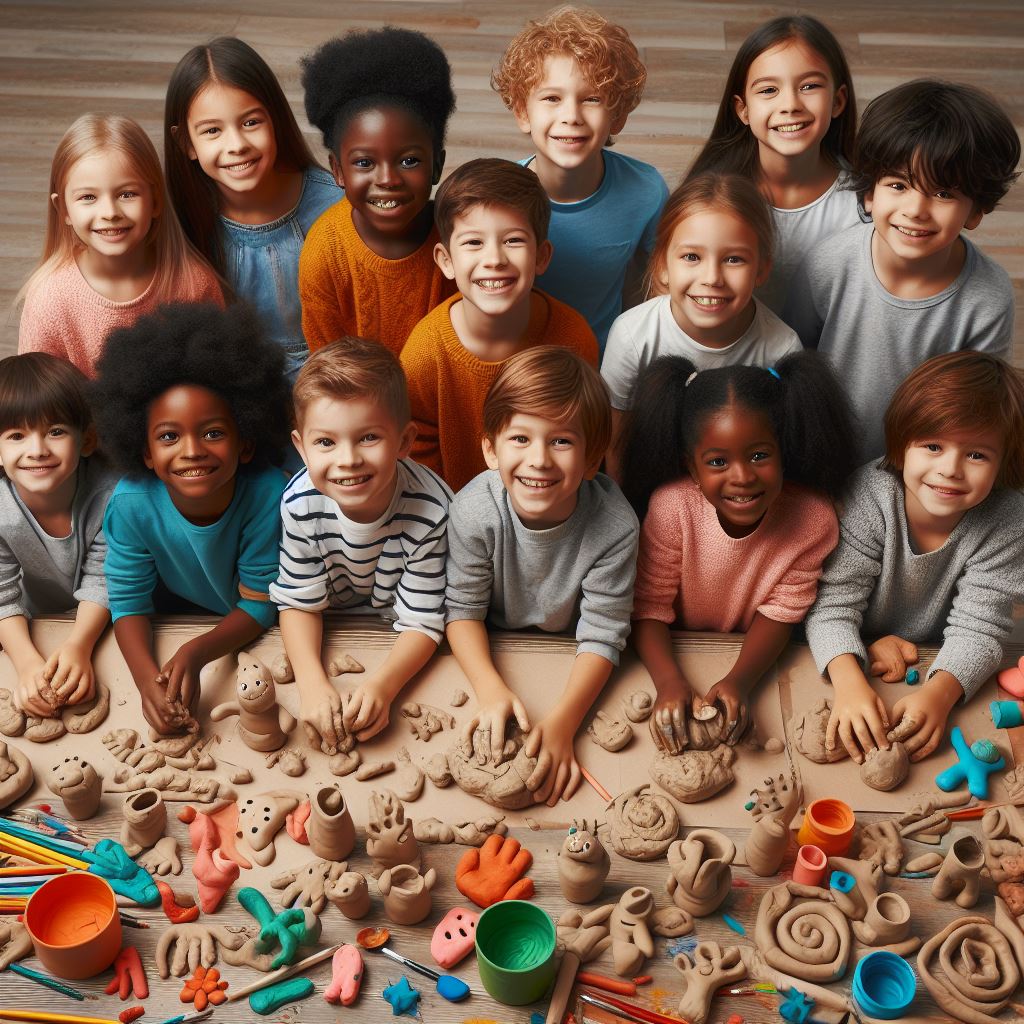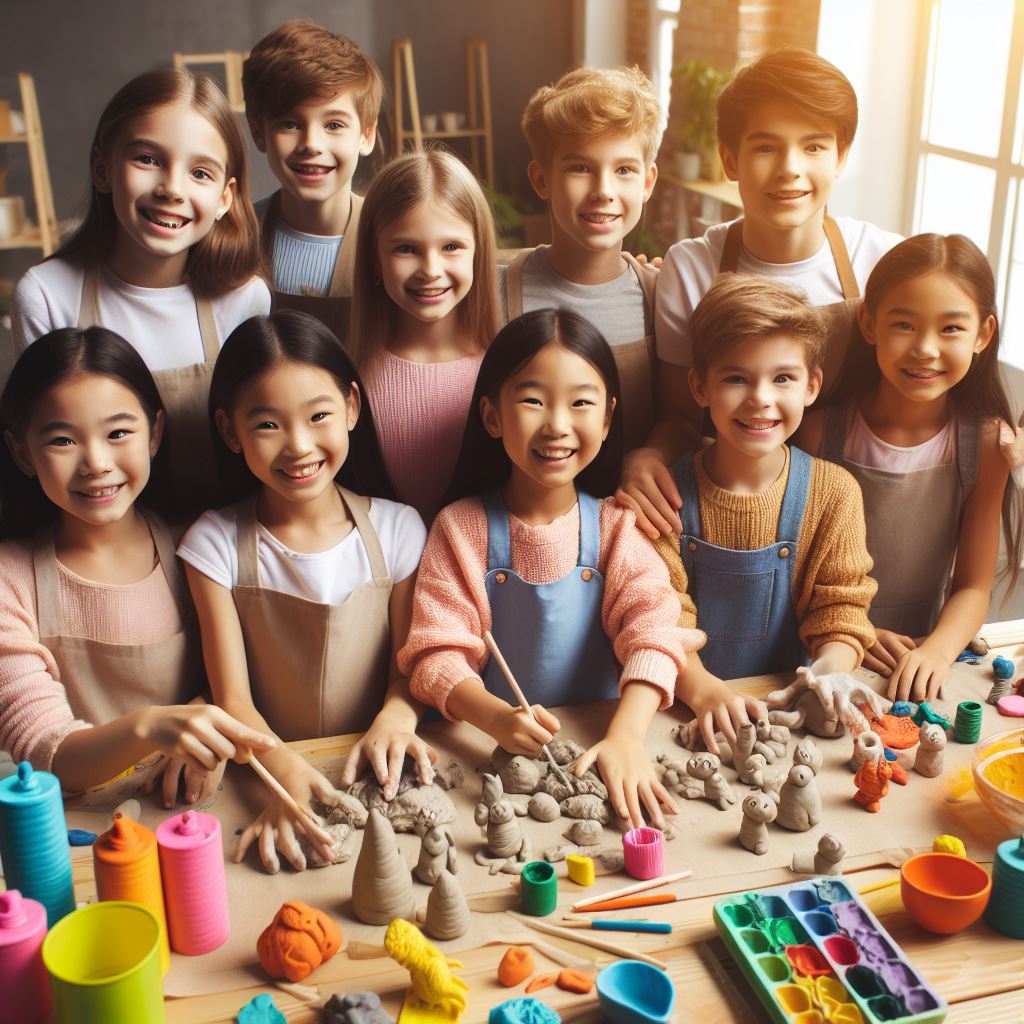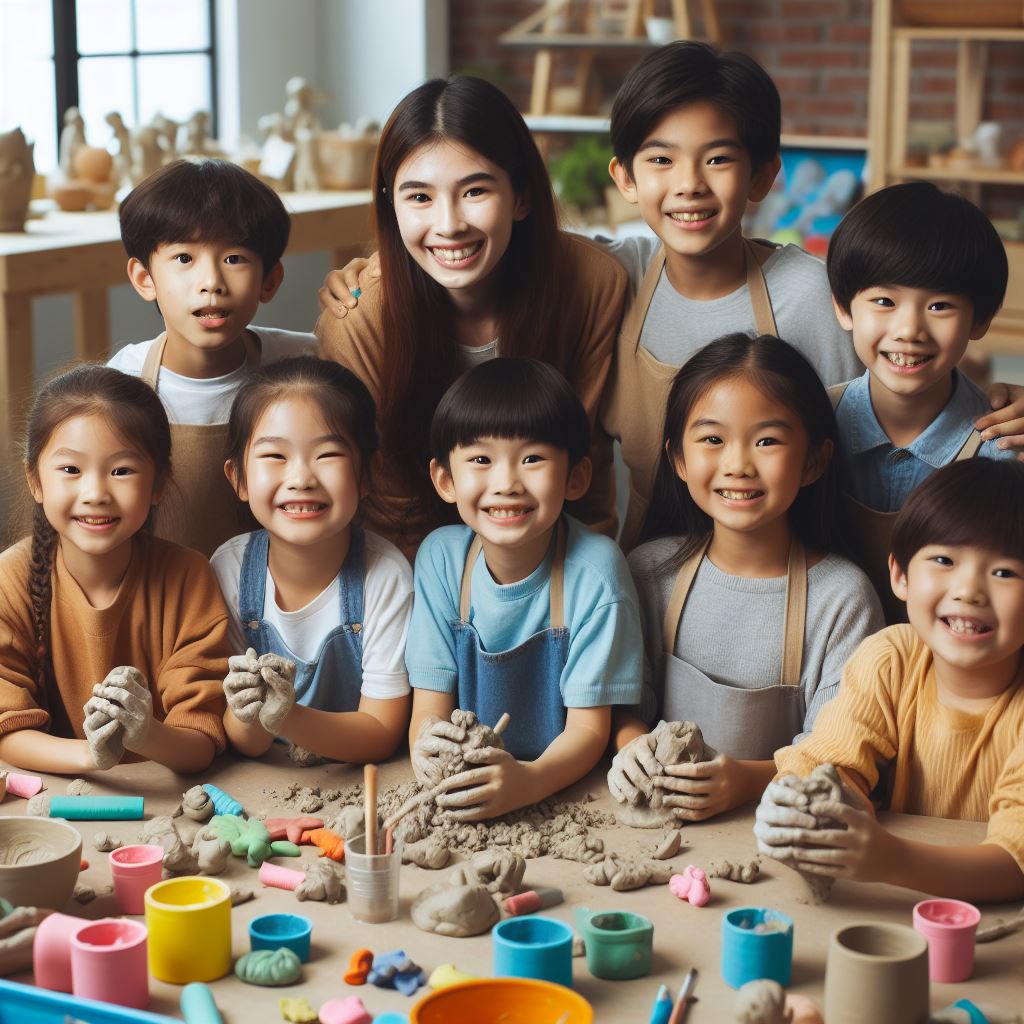Table Of Contents
- 1 Molding Minds and Mellowing Emotions: Sculpting with Clay for a Calmer Childhood
- 1.1 Decoding the Science: How Clay Sculpting Calms the Mind
- 1.2 Shaping Calmness: Techniques and Activities for Stress-Free Clay Play
- 1.3 1. Encourage Sensory Exploration:
- 1.4 2. Promote Open-Ended Creativity:
- 1.5 3. Focus on the Process, not the Product:
- 1.6 4. Create a Collaborative Space:
- 1.7 5. Incorporate Mindfulness Techniques:
- 1.8 Some Specific Activities You Can Try With Your Child:
- 1.9 Recap:
- 1.10 Key Takeaways:
- 1.11 FAQs:
- 1.11.1 1. At what age can children start sculpting with clay?
- 1.11.2 2. What type of clay is best for children?
- 1.11.3 3. How often should children engage in clay sculpting to see a reduction in stress and anxiety?
- 1.11.4 4. Can clay sculpting be used to address specific emotional challenges like anxiety disorders?
- 1.11.5 5. Where can I find resources and support for incorporating clay sculpting into my child’s routine?
- 1.12 Conclusion
Molding Minds and Mellowing Emotions: Sculpting with Clay for a Calmer Childhood

In today’s fast-paced world, children are increasingly exposed to various stressors and anxieties. From academic pressures and social challenges to family dynamics and global events, these stressors can significantly impact their well-being.
Fortunately, amidst this sea of anxieties, an ancient art form offers a unique and powerful tool for helping children find solace and calm: sculpting with clay.
This engaging activity provides a safe and nurturing space for children to express themselves creatively, release pent-up emotions, and develop valuable coping mechanisms. As they manipulate the malleable clay, they embark on a journey of self-discovery, fostering emotional well-being and reducing stress and anxiety.
In this four-part exploration, we will delve into the calming world of sculpting with clay, uncovering its transformative potential for children’s mental health. We will explore:
- The link between clay sculpting and stress reduction.
- The benefits of clay sculpting for emotional regulation and self-expression.
- Practical techniques and activities for incorporating clay sculpting into your child’s routine.
- Tips and resources for creating a supportive and calming environment for clay sculpting.
By the end of this journey, you’ll be equipped with the knowledge and tools to empower your child to navigate life’s challenges with greater resilience and inner peace.
Stay tuned for the next, where we will unpack the meaning behind “sculpting with clay for reducing stress and anxiety in children,” exploring the psychological and neurological mechanisms at play.
Decoding the Science: How Clay Sculpting Calms the Mind

Clay sculpting engages a multitude of senses, including touch, sight, and smell. This multisensory experience creates a calming effect on the brain, stimulating the release of dopamine and serotonin, two key neurotransmitters associated with feelings of happiness and well-being. Additionally, the act of manipulating the clay provides a sense of control and accomplishment, further alleviating anxiety and promoting relaxation.
Neuroimaging studies have shown that clay sculpting activates specific areas of the brain associated with emotional regulation, such as the prefrontal cortex and the amygdala. By engaging these areas, clay play helps to regulate the stress response and reduce anxiety levels in children.
Beyond the neurological benefits, clay sculpting offers a safe and expressive outlet for children to process their emotions. As they mold and shape the clay, they can externalize their inner turmoil, anxieties, and fears in a non-verbal and non-judgmental way. This process allows them to gain a better understanding of their emotions and develop healthy coping mechanisms for managing stress.
Furthermore, the tactile nature of clay provides a grounding and calming experience. The repetitive motions of kneading, shaping, and molding the clay offer a sense of focus and mindfulness, allowing children to be present in the moment and disconnect from their worries and anxieties.
Shaping Calmness: Techniques and Activities for Stress-Free Clay Play

Having explored the scientific basis for clay sculpting’s calming effect on children, let’s now dive into practical techniques and activities that can be easily incorporated into your child’s routine.
Here are some simple yet effective strategies for using clay sculpting to reduce stress and anxiety in children:
1. Encourage Sensory Exploration:
Provide a variety of clay textures and tools for your child to explore. Encourage them to touch, squeeze, and manipulate the clay, paying attention to the different textures and sensations. This sensory exploration promotes mindfulness and fosters a sense of calm.**
2. Promote Open-Ended Creativity:
Avoid imposing specific instructions or expectations. Allow your child to freely express themselves through the clay, creating whatever their imagination desires. This freedom encourages self-expression and promotes emotional release.**
3. Focus on the Process, not the Product:
Instead of emphasizing the final outcome, encourage your child to focus on the process of sculpting itself. The act of manipulating the clay, kneading, and shaping can be inherently therapeutic and calming.**
4. Create a Collaborative Space:
Turn clay sculpting into a shared activity. Work together with your child on a joint project, encouraging communication, cooperation, and positive social interaction. This shared experience can further enhance the calming and stress-reducing benefits of clay play.
5. Incorporate Mindfulness Techniques:
Combine clay sculpting with simple mindfulness exercises. Encourage your child to focus on their breath, be present in the moment, and observe the sensations they experience as they work with the clay. This mindfulness practice can further enhance the calming effect and promote emotional regulation.**
Some Specific Activities You Can Try With Your Child:

- Create stress balls: Shape the clay into small balls and encourage your child to squeeze them when they feel anxious or stressed.
- Make worry monsters: Help your child sculpt “worry monsters” and encourage them to share their worries and anxieties with these imaginary creatures.
- Build a calming scene: Encourage your child to create a calming scene out of clay, incorporating elements that bring them peace and relaxation.
- Mindful breathing exercises: While sculpting, guide your child through simple breathing exercises to promote focus and relaxation.
Remember, the key is to create a supportive and encouraging environment where your child feels safe to explore their emotions and express themselves freely through clay. By incorporating these techniques and activities into their routine, you can empower your child to manage stress and anxiety effectively and cultivate a sense of inner peace.
Recap:
We have now reached the conclusion of our journey through the calming world of clay sculpting for children. As we close this exploration, let’s recap the key takeaways and address any questions that may remain.
Key Takeaways:
- Sculpting with clay provides a safe and engaging outlet for children to express their emotions and manage stress.
- The tactile nature of clay, combined with the creative process, stimulates the release of calming neurotransmitters and activates areas of the brain associated with emotional regulation.
- Clay sculpting allows children to externalize their inner turmoil and process their anxieties in a non-judgmental way.
- Open-ended creative exploration, sensory engagement, and mindfulness practices enhance the stress-reducing benefits of clay play.
- Collaborative clay sculpting can promote positive social interaction and further decrease anxiety.
FAQs:
1. At what age can children start sculpting with clay?
Clay sculpting is a safe and rewarding activity for children of all ages. Even toddlers can benefit from exploring the tactile properties of clay under adult supervision.
2. What type of clay is best for children?
Non-toxic, air-drying clay is a good choice for younger children as it’s easy to use and doesn’t require firing. Polymer clay is also an option, but it requires baking in an oven.
3. How often should children engage in clay sculpting to see a reduction in stress and anxiety?
Just like any self-care practice, consistency is key. Encourage your child to sculpt with clay regularly, even for short periods each day. This regular engagement will provide them with a consistent outlet for managing stress and cultivate a sense of calm.
4. Can clay sculpting be used to address specific emotional challenges like anxiety disorders?
While clay sculpting can be a beneficial tool for managing anxiety, it’s important to consult with a mental health professional for specific diagnoses and treatment plans. Clay sculpting can be incorporated as part of a comprehensive approach to addressing emotional challenges in children.
5. Where can I find resources and support for incorporating clay sculpting into my child’s routine?
Numerous online resources, books, and workshops offer guidance and inspiration for parents and educators looking to incorporate clay sculpting into their children’s lives. Online communities and forums can also provide valuable support and networking opportunities.
Conclusion
By incorporating the knowledge and tools you’ve gained from this exploration, you can empower your child to navigate life’s challenges with greater resilience and inner peace. Remember, clay sculpting is more than just an art form; it’s a powerful tool for nurturing a child’s emotional well-being and cultivating a sense of calm. So, grab some clay, get creative, and watch your child blossom into a calmer and more confident individual.
1 thought on “Sculpting With Clay For Reducing Stress And Anxiety In Children”